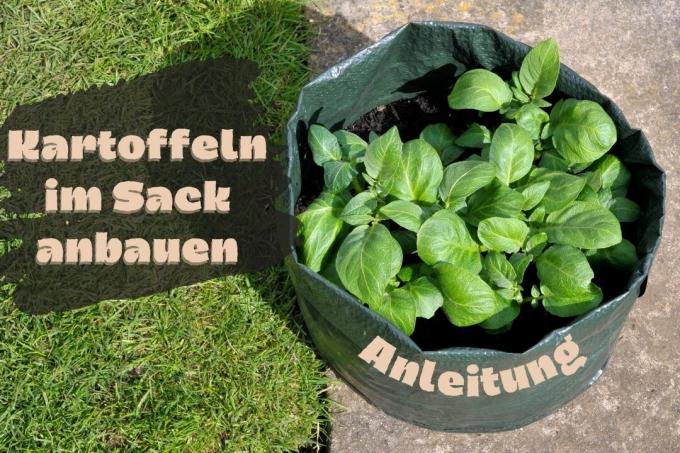
table of contents
- Potato cultivation in the sack
- Materials required
- instructions
- care
- Harvest and storage
- frequently asked Questions
Would you like to harvest your own potatoes but don't have a garden? That is not an obstacle! We will introduce you to a space-saving cultivation method that can even be used on the balcony: planting potatoes in a sack.
In a nutshell
- Plant bags are a space-saving option for adding potatoes and other vegetables
- rice or jute sacks are used
- a sunny location is required
Potato cultivation in the sack
Why should you plant and grow potatoes in a sack? The advantages are apparent:
- The cultivation method is uncomplicated and requires little space.
- Potato cultivation is possible on areas with poor soil quality. Nutrient-rich substrate is only needed to fill the sack. The plant sack enables that Composition of the substrate to optimally match the requirements of the potatoes.
- the Settlement of weeds is with this method limited. Weeding is almost completely eliminated.
- the evaporation the water gets through the sack reduced.
- Peststhat attack the tubers or roots are for the most part through the sac prevented.
- Plant sacks ensure a good root growth. Root rot occurs very rarely with this cultivation method.
- the harvest the potatoes is simple. Injuries to the potato tubers are prevented as there is no need to dig them up with a spade.
- Plant bags convince with their mobility. You can easily move smaller bags to another location or even take them with you when you move.

Materials required
To begin the exciting adventure of planting potatoes in a sack you need:
- a sack with a volume of about 50 liters
- 5 potatoes
- 40 liters of substrate
- Expanded clay or coarse gravel as drainage
The plant sack
The following are suitable for growing table potatoes and vegetables in the sack:
- Burlap sacks
- Rice bags
- Sacks of coarse fabric
- Plastic plant bags
Note: In specialist shops you can get ready-made plant bags, so-called grow bags, fully assembled with seeds, drainage material and prepared substrate.

The substrate
The potato (Solanum tuberosum) is one of the heavy eaters. It needs nutrient-rich, well-drained, humus-rich and sandy substrate. You can use commercially available vegetable soil that you mix with sand. The optimal pH of the soil for growing potatoes is between 5 and 6.
instructions
Planting potatoes in a sack is very easy. See here:
-
Pre-germinate
Let the seed potatoes germinate in a light place, for example on the windowsill, at around 10 degrees Celsius. Place the seed potatoes in fruit boxes with a little space between them. It is important that they get as much light as possible from all sides.
Tip: Make sure that the crown of the potato tubers, where the sleeping eyes sit, is facing up.
-
Prepare the planting sack
Avoiding waterlogging is crucial for a good harvest. Cut a few inches of drainage holes in the bottom of the jute, cloth, or rice sack. If you place the planting sack on the balcony or terrace, put a film under it. Otherwise there will be unsightly stains. Roll up the sack up to 30 centimeters.
-
Fill in drainage
Fill the sack with a five-centimeter layer of expanded clay or gravel.
-
Fill in substrate
Fill in substrate to a height of 20 centimeters.

-
Plant potatoes in the sack
The seed potatoes can be used from the end of April. Place the tubers with the germ tips facing up. Fill in about two inches of substrate so that they are lightly covered. Now you need to water the planting and wait.
care
-
Refill substrate
The first green leaves will appear after about 14 days. Roll up the fabric sack and pour in enough substrate until the leaves can no longer be seen. Repeat this process over and over again in the following weeks when green leaves show up. After five to six weeks the sack is full of earth. The leaves that then make it through the earth are allowed to unfold.
-
to water
Water the plants regularly. Make sure the soil stays moist.
Tip: If you want, you can put the rice or jute sack in a brightly painted, old potato box. Make sure that the water can be drained unhindered.
Harvest and storage
In late summer the foliage becomes wilted and dry. Wait two to three weeks and the tubers are ripe. You can dump the sack and easily pick out the potatoes. Store the potato crop in a dark, dry and cool place.
frequently asked Questions
We recommend using plant bags with a capacity of around 50 liters for growing potatoes. These offer enough space for five potato plants and can be moved if necessary.
Jute sacks, rice sacks and standard plastic plant bags are stable and can be used several times. Wash the bags after use. Let them dry well to prevent mold.
Planting in the sack requires more moisture than ordinary soil culture. The water flows through the coarse fabric to the outside so that waterlogging can be avoided as far as possible. The substrate must not dry out. Water regularly.
You can also grow the delicious tubers in tall pots and tubs. Old rain barrels or masonry buckets are suitable alternatives. The sun's rays slowly heat up the dark walls so that the plants can develop well. It is important to provide the vessels with drainage holes. Otherwise, the procedure is the same as for cultivation in the sack.

